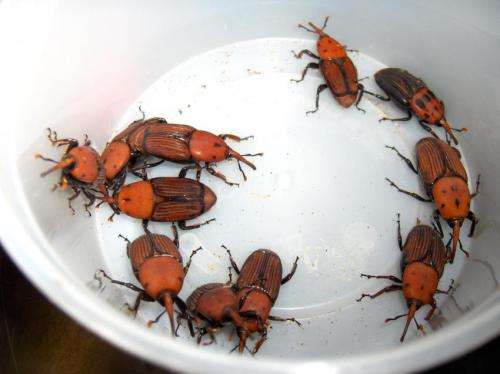Researchers study the flight pattern of the red palm weevil in order to set more efficient control measures

What is the average distance that the red palm weevil covers? Does the insect's sex, age and body size have an influence on its flight potential? Researchers of the Universitat Politècnica de València have released a study that answers these and other questions. The results allow them to learn more about the flight pattern of this insect, which is threatening palm trees all over the world, in order to set new preventive and curative measures against the pest.
The study, published in the Bulletin of Entomological Research, has been developed in the laboratories of the Mediterranean Agroforestal Institute (IAM, in Spanish) in collaboration with the Department of Computer Engineering (DISCA, in Spanish) of the UPV. The work team analysed the insect behaviour with a camera fitted with a flight mill connected to a computer. They tested parameters such as the distance covered, the flight length, and average and maximum speed.
Among their conclusions, the study states that most of analysed insects -54%- covered a short distance, less than 100 metres; 36% flew between 100 and 5000 metres; and 10% was able to fly more than 5000 metres.
"If we compare the results with similar studies done under field conditions, we conclude that when an insect is detected, all the palm trees within 500 metres run the risk of being weevil-infested", says Antonia Soto, researcher at the Mediterranean Agroforestal Institute of the UPV.
With regard to the sex, they determined that it does not affect the flight potential of the insect. While in the case of age, they noticed that the average of flying individuals is larger in insects between 8 and 23 days-old than in the newly hatched insects.
"The conclusions that we have obtained support the studies that we have done under field conditions and they give significant clues about insect mobility. This information helps to improve the management of this pest and to find more efficient control measures. For example, in a newly detected source of palm trees with red palm weevil, now we know up to what distance we must apply control measures in order to avoid or at least reduce the dispersion of the pest. Or we know the safety perimeter that must be applied in an area with red palm weevil presence," adds Juan Antonio Ávalos, researcher at the Mediterranean Agroforestal Institute of the UPV.
Field tests
During the field tests, the researchers of the UPV have proved that most of the Rhynchophorus ferrugineus adults dispersed flew a short distance, less than 500 metres, which coincides with the results obtained in the laboratory. On the other hand, the maximum distance at which the adults were recaptured was 7 kilometres from the point where they were released. In the laboratory, they obtained a much larger flight potential, almost 20 kilometres.
More information: Ávalos, J.A., Martí-Campoy, A., Soto, A. Study of the flying ability of Rhynchophorus ferrugineus (Coleoptera: Dryophthoridae) adults using a computer-monitored flight mill. Bulletin of Entomological Research, 2014, volume 104, issue 04, pp. 462-470. DOI: 10.1017/S0007485314000121
Provided by Asociacion RUVID


















